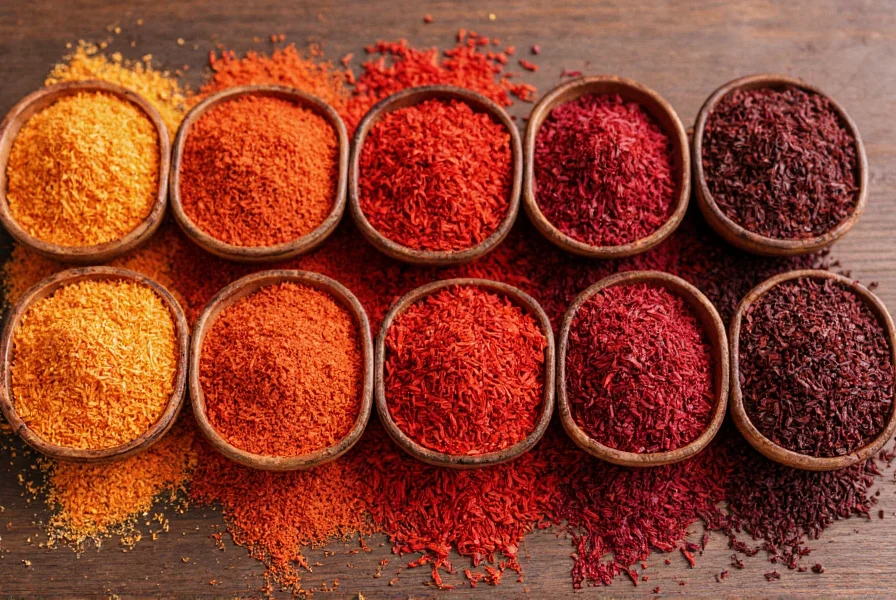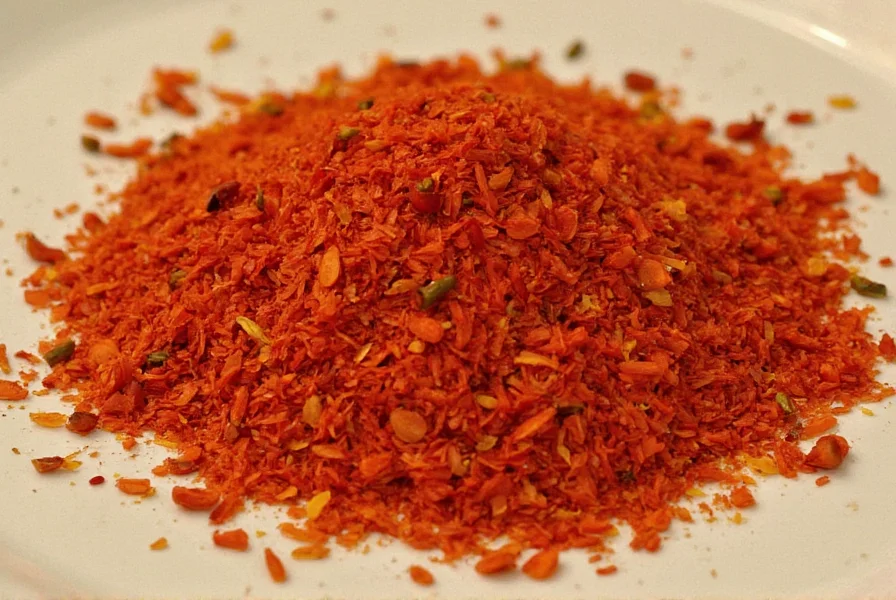Understanding chili flakes is essential for any home cook looking to add authentic heat and depth to their dishes. These vibrant red fragments bring more than just spiciness—they contribute complex flavor notes that can transform simple recipes into culinary delights. Whether you're making pizza, pasta, or Asian stir-fries, knowing how to properly use chili flakes can elevate your cooking significantly.
What Exactly Are Chili Flakes?
Chili flakes, sometimes called crushed red pepper, consist of dried and broken pieces of various hot chili peppers. The most common variety found in supermarkets comes from cayenne peppers, but authentic versions might include a blend of different chili types like bird's eye, serrano, or even specialty peppers depending on regional traditions.
The production process involves harvesting ripe chili peppers, drying them thoroughly (either in the sun or using dehydrators), then crushing them into small flakes. Unlike chili powder which is finely ground, chili flakes maintain visible texture and often include small pieces of chili skin, seeds, and membranes—the parts containing most of the capsaicin responsible for heat.
Flavor Profile and Heat Levels
Chili flakes offer a distinctive flavor profile that goes beyond simple heat. They provide:
- A bright, slightly fruity undertone
- Earthy notes from the dried pepper skins
- Variable heat intensity depending on the pepper variety
| Chili Flake Type | Scoville Heat Units | Flavor Characteristics |
|---|---|---|
| Standard Crushed Red Pepper | 30,000-50,000 | Sharp, slightly smoky, moderate heat |
| Calabrian Chili Flakes | 25,000-45,000 | Fruity, complex, with citrus notes |
| Sichuan Chili Flakes | 15,000-30,000 | Milder heat with distinctive numbing sensation |
| Bird's Eye Chili Flakes | 50,000-100,000 | Intense heat with floral undertones |
The heat level can vary significantly between brands and regions. Italian-style crushed red pepper tends to be milder with more emphasis on flavor, while Asian varieties often pack more intense heat. When shopping for chili flakes, check if the packaging specifies the pepper variety for better predictability in your cooking.
Chili Flakes vs. Similar Products: Key Differences
Many home cooks confuse chili flakes with other spicy ingredients. Understanding these differences is crucial for recipe success:
Chili Flakes vs. Chili Powder
This is perhaps the most common point of confusion. While both come from dried chilies, they're fundamentally different:
- Chili flakes are simply crushed dried chilies with no additional ingredients
- Chili powder is typically a spice blend containing ground chilies plus other spices like cumin, garlic powder, and oregano
Substituting one for the other can dramatically alter your dish's flavor profile. If a recipe calls for chili flakes, using chili powder will introduce additional flavors that might not be desired.
Chili Flakes vs. Fresh Chilies
Fresh chilies offer moisture and a brighter, grassier heat, while chili flakes provide concentrated, dried heat with deeper, sometimes smokier notes. The conversion isn't direct—generally, ½ teaspoon of chili flakes equals one medium fresh chili, but this varies by pepper type.
When and How to Use Chili Flakes in Cooking
The timing of adding chili flakes significantly impacts their flavor contribution:
- Early in cooking: Adds deep, integrated heat that permeates the entire dish (ideal for stews, braises)
- Middle of cooking: Provides balanced heat that's noticeable but not overwhelming
- At the end or as garnish: Delivers bright, sharp heat with visible red flakes (perfect for pizza, pasta, or finished dishes)
For oil-based dishes, try infusing chili flakes by heating them gently in oil for 1-2 minutes before adding other ingredients. This technique, common in Italian and Asian cuisines, releases maximum flavor without burning the flakes.
Proper Storage for Maximum Freshness
Like all dried spices, chili flakes lose potency over time. To maintain their vibrant color and heat:
- Store in an airtight container away from light and heat
- Keep away from the stove or other heat sources
- Use within 6-12 months for best flavor (though they remain safe indefinitely)
You can tell chili flakes have lost potency when they turn from bright red to dull brownish-red and the heat diminishes significantly. Properly stored, high-quality chili flakes should retain their characteristic aroma and vibrant color.
Best Substitutes When You're Out of Chili Flakes
Ran out of chili flakes mid-recipe? Consider these alternatives:
- Crushed dried chilies: The closest substitute, though may require additional crushing
- Hot paprika: Provides similar color with milder heat (use ½ the amount)
- Red pepper flakes in oil: Use the oil and some flakes, adjusting for liquid content
- Fresh chopped chilies: Use half the amount of fresh chilies for equivalent heat
Remember that substitutions will alter your dish's flavor profile. For authentic results, especially in regional cuisines, seek out the specific chili variety called for in the recipe.
Regional Varieties Worth Exploring
While standard crushed red pepper is widely available, exploring regional varieties can transform your cooking:
- Italian Calabrian chili flakes: Fruity with moderate heat, perfect for pasta and pizza
- Sichuan chili flakes: Distinctive numbing quality essential for authentic Chinese dishes
- Korean gochugaru: Technically a powder but available in flake form, with unique sweet-heat profile
- Mexican arbol chili flakes: Sharp, clean heat ideal for salsas and marinades
Each variety brings its own character to dishes, so experiment to find which works best for your preferred cuisine. Specialty food stores and online retailers often carry these regional varieties.
Practical Tips for Using Chili Flakes Effectively
Master these techniques to get the most from your chili flakes:
- Toast before use: Briefly heat in a dry pan to intensify flavor (watch carefully to prevent burning)
- Control heat distribution: Sprinkle evenly over dishes rather than dumping in one spot
- Balance with acid: Pair with lemon juice or vinegar to create more complex heat
- Make chili oil: Steep flakes in olive oil for versatile spicy condiment
- Use in moderation: Start with less than you think you need—you can always add more
Remember that heat perception varies among individuals. When cooking for others, consider adding chili flakes as a finishing touch so each person can adjust to their preference.


Frequently Asked Questions
What's the difference between chili flakes and crushed red pepper?
Chili flakes and crushed red pepper are essentially the same product. The term "crushed red pepper" is commonly used in American supermarkets, while "chili flakes" is more internationally recognized. Both refer to dried, crushed chili peppers, though specific pepper varieties may differ by region and brand.
Can I make my own chili flakes at home?
Yes, making homemade chili flakes is straightforward. Simply dry fresh chili peppers completely (using a dehydrator or oven on lowest setting), then crush them using a mortar and pestle or spice grinder. For best results, remove stems but keep some seeds for extra heat. Store in an airtight container away from light and heat.
Why do some chili flakes contain different colored pieces?
The variation in color comes from using multiple chili varieties in the blend. Some producers mix different peppers to create complex flavor profiles. The darker pieces are often from more mature peppers or different varieties with naturally darker color. This color variation typically indicates a more complex flavor profile rather than a quality issue.
How can I reduce the heat of a dish that has too many chili flakes?
To reduce excessive heat from chili flakes, add dairy products like yogurt or cream, which contain casein that binds to capsaicin. Acidic ingredients like lemon juice or vinegar can also help balance the heat. Adding more of the other ingredients (like tomatoes in a sauce) to dilute the spiciness works well. Sugar or honey can counteract heat perception, but use sparingly to avoid altering the dish's flavor profile.
Are chili flakes gluten-free and suitable for special diets?
Pure chili flakes made from only dried chilies are naturally gluten-free, vegan, and paleo-friendly. However, check labels carefully as some commercial blends may contain anti-caking agents or be processed in facilities with gluten. For strict dietary requirements, look for certified gluten-free products or make your own from dried chilies to ensure no cross-contamination.











 浙公网安备
33010002000092号
浙公网安备
33010002000092号 浙B2-20120091-4
浙B2-20120091-4